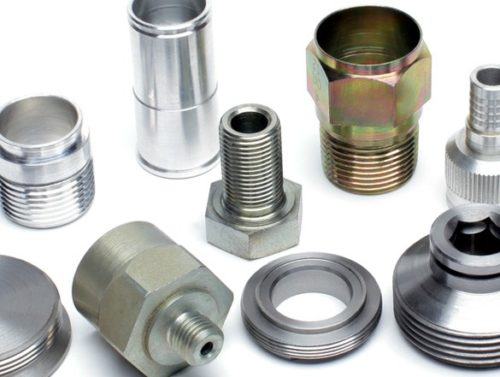Precision CNC Turning
Precision CNC turning is an engineering procedure that uses a lathe to create complex, custom-made components. The process involves inserting a single-point cutting tool parallel to the material to be machined . Then, the material is spun at varying speeds, and the tool cutting traverses to generate precise circular cuts.
At DACRUZ Manufacturing, we manufacture high- and low-complexity components for critical subassemblies and components. When applications necessitate great precision, our CNC Swiss machining and CNC multi-axis machines offer unmatched precision and consistency for both large and low-volume production runs.
CNC Swiss Machining

Also referred to as Swiss-type lathes or automatic lathes, Swiss CNC machines are precision manufacturing equipment designed to make very small components with optimal precision and speed.
The Swiss machining method involves feeding bar stock through a guide bushing, which sustains the material as it flows into the tooling area of the machine. Only the section of the bar stock being machined enters the tooling region, securing the material securely in place. This ensures optimal precision and stability.
Swiss lathes can simultaneously conduct operations in separate zones, resulting in significant time savings.
CNC Swiss Machining Applications and Benefits
CNC Swiss machining can produce small, intricate parts in large quantities for various industries, including electronics, defense, medical, and automotive. Furthermore, it is capable of manufacturing components for a variety of uses, including the following:
Aerospace Parts
Precision CNC turning allows aerospace parts to be created for optimal compatibility. Typically, CAD software operates a CNC lathe machine that rotates at high speeds and removes extra material. This adds to the reliability of the aerospace industry by enabling the cooperation of precise components.
Connecting Components for Electronic Devices
As electronic gadgets continue to reduce in size, CNC Swiss machines can manufacture components for the ever-evolving and expanding electronics industry. Moreover, they can repeatedly create parts at high rates with exceedingly precise tolerances.
Firing Pins
CNC swiss machines are utilized to make a firing pin which is the component that pierces the cartridge’s primer when the hammer is released. The firing pin may also be located on the hammer if the firearm is a revolver, as revolvers lack bolts and striker assembly.
Medical Devices
Nowadays, CNC Swiss turning machines are the industry standard for the manufacture of medical devices. In contrast to traditional turning machines with immobile headstocks, Swiss turning machines have movable headstocks. This enables the creation of intricate shapes for medical equipment in less time.
Optical Equipment
Optical industry components are manufactured with the highest quality and accuracy to guarantee easy installation in complex equipment, such as microscopes, lasers, and telescopes. Therefore, they require advanced CNC machines to achieve the industry’s stringent requirements and ensure the tightest tolerances possible.
Shafts
Precision CNC turning is the most prevalent method used to create shafts. Workers or automated processes attach or clamp material bars to chucks and rotate them using this method.
Timepieces
CNC Swiss machines are used in time-measuring systems needing exceptional precision and accuracy. Also, they are excellent for clocks, watches, and timers since they can accommodate even the smallest component.
CNC Multi-Axis Turning

CNC multi-axis turning involves tool movement in four or more directions. These instruments are used to shape sculptures and create CNC precision-turned components from metal and other materials. Moreover, excess material is removed through techniques like laser or waterjet cutting.
The number of axes on CNC multi-axis turning machines ranges from 4 to 12. Therefore, this technology is ideally suited for creating patterns in various materials and creating complex parts fast and efficiently. Furthermore, CNC multi-axis turning equipment can be used with substrates like steel, aluminum, plastics, and even ceramics.
CNC Multi-Axis Turning Applications and Benefits
The major objective for components produced using this method is to complete the full machining process in a single configuration. Several industries rely on CNC multi-axis turning, including aerospace, automotive, energy, defense, and more.
Here are some advantages of this process:
- The ability to make extremely intricate shapes
- Fewer setups necessary
- Increased relational precision
- Longer tool durability
- Enhanced surface finish
Materials
Multiple materials are well-suited for multi-axis machining. DACRUZ Manufacturing produces unique components with the following materials:
Aluminum
Aluminum is suitable for many applications due to its high strength-to-weight ratio and corrosion resistance. It also possesses excellent thermal and electrical conductivity.
Steel
There is a vast selection of steel CNC machining materials. Various steel grades and alloys are machinable and possess excellent mechanical qualities.
Stainless Steel
A significant advantage of stainless steel is its corrosion resistance, even after being scratched. This is because the chromium in stainless steel produces an invisible coating over the iron that protects it from external influences.
Plastic Polymers
Certain industrial plastics are efficient, cost-effective alternatives to metal components. They are also lightweight, resilient, and adaptable, with uses in various sectors.
Precision CNC Turning Services at DACRUZ Manufacturing
DACRUZ Manufacturing has produced highly precise machined components for various sectors for over four decades! We take pride in providing well-produced parts at reasonable pricing. Moreover, our CNC machines provide unmatched precision for large and small production runs.
Contact us or request a quote to learn more about our precise CNC machining skills!












